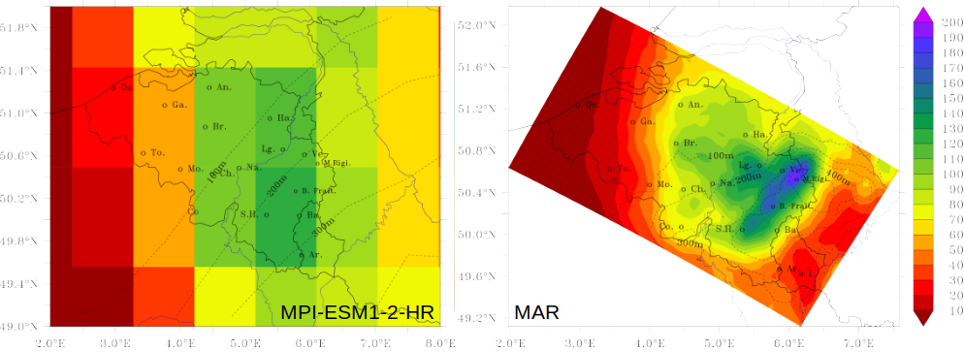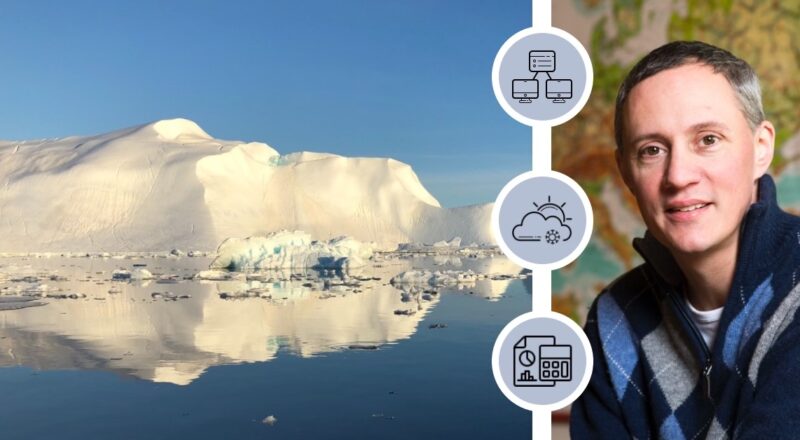High Performance Computing (HPC) enables complex computations and massive data to be processed at high speeds far beyond human capabilities with thousands of compute nodes enabling one or more tasks in parallel.
Climatology (and meteorology) are among the sectors that make the most use of high-performance computing.
And this is precisely the subject that we have chosen to address with Xavier Fettweis, Climatologist and Professor at the University of Liège in Belgium.

Picture, Jean Louis Wertz
Xavier Fettweis uses the Regional Atmospheric Model (MAR), a three-dimensional climate model with high spatial resolution. Developed since the end of the 1990s to study the polar regions (and in particular the melting of the Greenland ice sheet), the MAR model is actively used by the Climatology Laboratory of the University of Liège. “We are running our MAR model over Greenland, Antarctica and Europe. Thanks to this internationally recognized model, we have become a reference research lab for the IPCC, to which we provide results quantifying the sea level rise from the melting of the polar ice caps. We need to perform future projections of 150 years (1950-2100) for each global model and each scenario. The MAR model is also used, of course, to establish very precise weather forecasts or future climate projections for Belgium. »
HPC, an essential tool for climate simulation?
The development of climate models and their use to predict and understand the climate system has been made possible through the use of HPC and the growth of computing power. “Such climate simulations would be impossible to perform without supercomputers. For example, if we want to run the MAR model over 150 years, we initiate several simulations in parallel covering periods of 5 years. Given that the operation must be carried out for about ten global models selected from the IPCC database (there are around thirty in all) and this, for the 4 main future Greenhouse gases scenarios of the IPCC, we need to simulate thousands of years! »

How long does it take to simulate a year?
“I would say that with 12 CPUs, a year of MAR simulation over Belgium at 5 km resolution takes around 1 to 2 days of calculation. For polar regions it may be longer, depending on the spatial resolution; the higher the spatial resolution, the longer it takes. A gain in spatial resolution of a factor of 2 needs a factor of 8 in computer time. To give you an order of magnitude, carrying out a year of simulation typically takes 3 to 4 days to cover Greenland at a resolution of 10 km and a week of computing is roughly needed to cover Antarctica at a resolution of 20 km. »
The use of local and/or European supercomputers
As mentioned earlier, climatology is one of the sectors that consumes the most intensive computing. “Each country uses, in priority, local computing infrastructures, whether for meteorology or climatology. Running climate models requires a lot of CPUs, which justifies the use, as a priority, of local supercomputers. The Climatology Department of the University of Liège uses the supercomputing infrastructures of Cenaero and CECI. It also happens that some programs run on international supercomputers, whether in Finland or Italy, where we have access to the international supercomputer of the European Center (ECMWF) used, in particular, for medium-term weather forecasts. »
Environmental impact of the use of HPC
Supercomputers are energy-intensive. Can we assess the « balance » between energy consumption and « ROI » of the activity?
“This is a very good question that concerns the community of climatologists: carrying out a lot of calculations to demonstrate global warming can seem absurd. This is why it might be good to space out the publication of IPCC reports. Because systematically publishing a report every 5-7 years is not necessarily useful: science has not always evolved and it is sometimes useless to rerun all the climate models (the global models, the regional models and the climate impact models) to obtain results which, at the end, will probably be very close to those ones of the previous report. Of course, this does not preclude carrying out, between two reports, important simulations if an improvement in the models or an observation suggests that an important process or a positive feedback has not yet been taken into account in the future projections of the climate. »
High Performance Computing revealing global warming?
The latest IPCC reports have pointed to recent climate changes and have finally established a direct link between human activity and global warming. Could this observation have been established thanks to supercomputers?
» Quite! By integrating the increase in greenhouse gases into global models, we have been able to reproduce, by simulation, the changes we observe today, namely: temperature increases, the melting of the polar ice caps, the sea level rise, more frequent and more intense extreme events, etc. If we do not integrate greenhouse gas emissions emitted by human activities, then the models are no longer able to simulate the changes we are experiencing today. This is how the IPCC was able to establish an unequivocal link between human activity and global warming. Thirty years ago, only models suggested global warming, whereas today, observations confirm what the models predicted. »
Belgium, driver of change?
In Belgium, the main source of CO2 emissions is the transport of goods and people. “To help limit our carbon footprint, the ideal would be to favour the transport of local goods by train. This would already be a preferred course of action. In the same way as the adoption of the “Stop au Béton” measure in order to preserve green spaces and limit built-up (concrete) spaces by giving priority to renovation projects in favour of new constructions. Belgium and Europe should be an example by taking actions because if we want to limit global warming to +1.5°C in 2100, we must act now! »
« Climate Modellers »: a highly sought-after profile!
Significant investments are currently being made in climate research and some profiles are missing; this is the case of climate modellers.
These profiles, in general, graduates in exact sciences (geographers, physicists, mathematicians, …) or applied sciences (engineers, computer scientists, …) are highly sought after by the climatology sector but also by the world of insurance and renewable energies by example. Interested to know more? ☞ https://www.youtube.com/watch?v=OEN8z_XfzCA
Image © Dominique Müller

